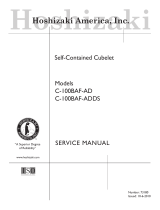
15
9) Ice Purge Cycle–"GM" LED is on. UFS closes (WV de-energizes) and "WTRIN"
LED turns off. 5-sec. GM delay timer and 30-min. FZT start. 5-sec. GM delay timer
terminates. GM and GMPR energize. 5-min. IPT starts. GM runs for 5 min. to clear
any ice from the evaporator. Diagnosis: If "GM" LED is off, check that UFS closed.
If UFS is closed and "GM" LED does not turn on, replace CB. If "GM" LED is on and
GM is off, conrm 115VAC at CB K1 connector pin #2 (BR) to neutral (W). Check for
115VAC at CB K1connector pin#3 (DBU) to a neutral (W). If no voltage is present at
CB K1 connector pin #2 (BR), check wiring connections. If no voltage is present at CB
K1connector pin#3 (DBU), replace CB. If115VAC is present, check 115VAC 3A GM
fuse, GM internal protector, GM windings, capacitor, and GM coupling between auger
and GM. If GM internal protector is open, allow to cool and reset. If reset does not
occur, replace GM. If Comp energizes at the same time GM energizes, check CB.
See "II.C.Control Board Check."
10) Freeze Cycle–"COMP" and "GM" LEDs are on. 5 min. IPT terminates. GM continues.
CB conrms GM operation through GMPR terminal #3 (W/O) and terminal #5(W/O).
Comp and FM energize. Ice production begins 4to 6min. after Comp and FM energize
depending on ambient and water temperature conditions. Diagnosis:5 min. after GM
energizes, conrm Comp LED turns on and Comp and FM energize. If not, check
that GMPR is energized (115VAC). Next, check continuity between GMPR terminal
#3(W/O) and terminal #5 (W/O). If open, GMPR is de-energized or defective. If closed,
and "COMP" LED is not on, replace CB. If "COMP" LED turns on and Comp and FM
do not energize, conrm 115VAC at CB Comp X1 relay (BR) to a neutral (W). If 115VAC
is not present, check connections. If 115VAC is present, conrm 115VAC at CB Comp
X1relay (R) to a neutral (W). If 115VAC is not present and "COMP" LED is on, replace
CB. If 115VAC is present, check Comp external protector (overload), allow to cool and
reset. If reset does not occur, replace external protector. Check Comp start and run
capacitors, Comp start relay, and Comp windings. If FM does not energize, check FM
run capacitor, that the fan blade is not binding, and that FM windings are good.
11) Rell/Low Water Safety–"COMP," "GM," and "WTRIN" are on. As ice is produced,
the water level in the reservoir drops. UFS opens. Nothing happens at this time. When
LFS opens, 90-sec. FTstarts. WV energizes. Comp, FM, and GM continue. As water
lls the reservoir, LFS closes. Nothing happens at this time. When UFS closes, WV
de-energizes, 90-sec. FT terminates, and 30-min. FZT resets. This continues until BC
shuts down the appliance or power is turned off to the appliance. Diagnosis: Conrm
that the water level has dropped and UFS and LFS are open. See "II.E. Float Switch
Check and Cleaning." Check for dirty or sticking oat switches, clogged WVscreen,
defective WV coil, or DV leaking by. If UFS remains open 90 seconds after LFS opens
(WV energized), a 1-beep alarm sounds (90 sec. FT). This alarm resets automatically
once UFS closes. Comp and FM de-energize. GM de-energizes 90 sec. later. WV and
alarm continue until UFS closes.
Note: Each time UF/S closes, 30-minute FZT starts. 30-minute FZT resets when UF/S
closes again. If UF/S does not close again within 30 minutes, CB shuts down the
appliance and sounds a 5-beep alarm every 5 seconds. See "III.B. LED Lights
and Audible Alarm Safeties."


























